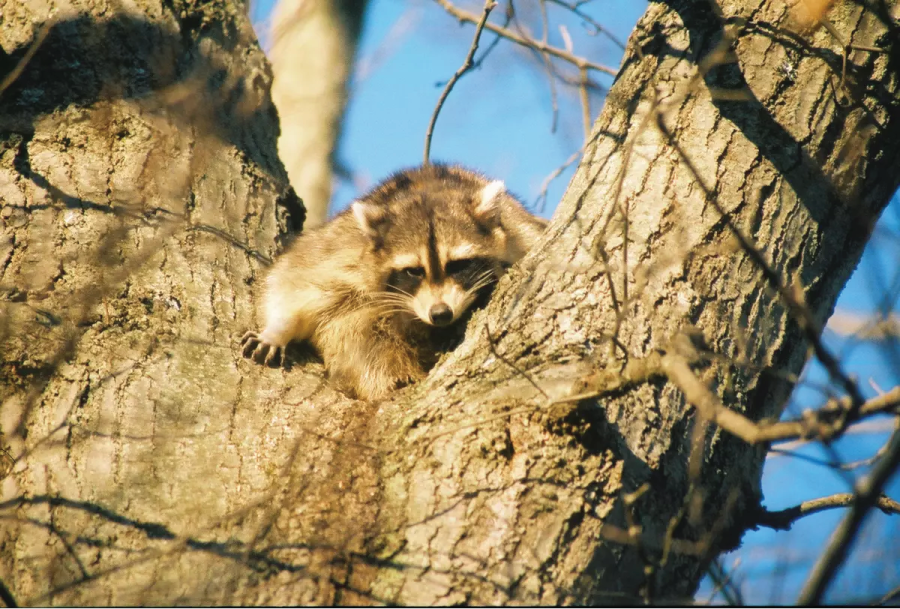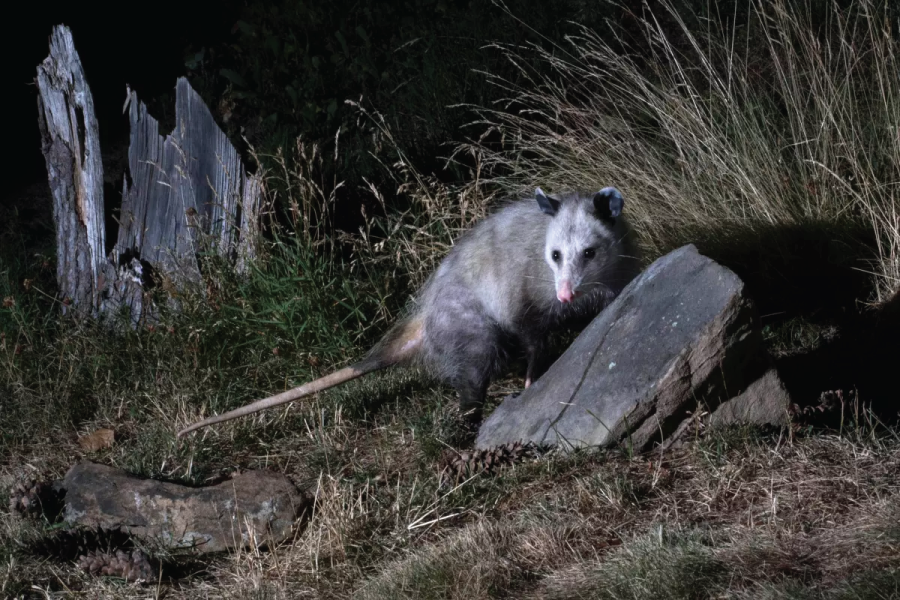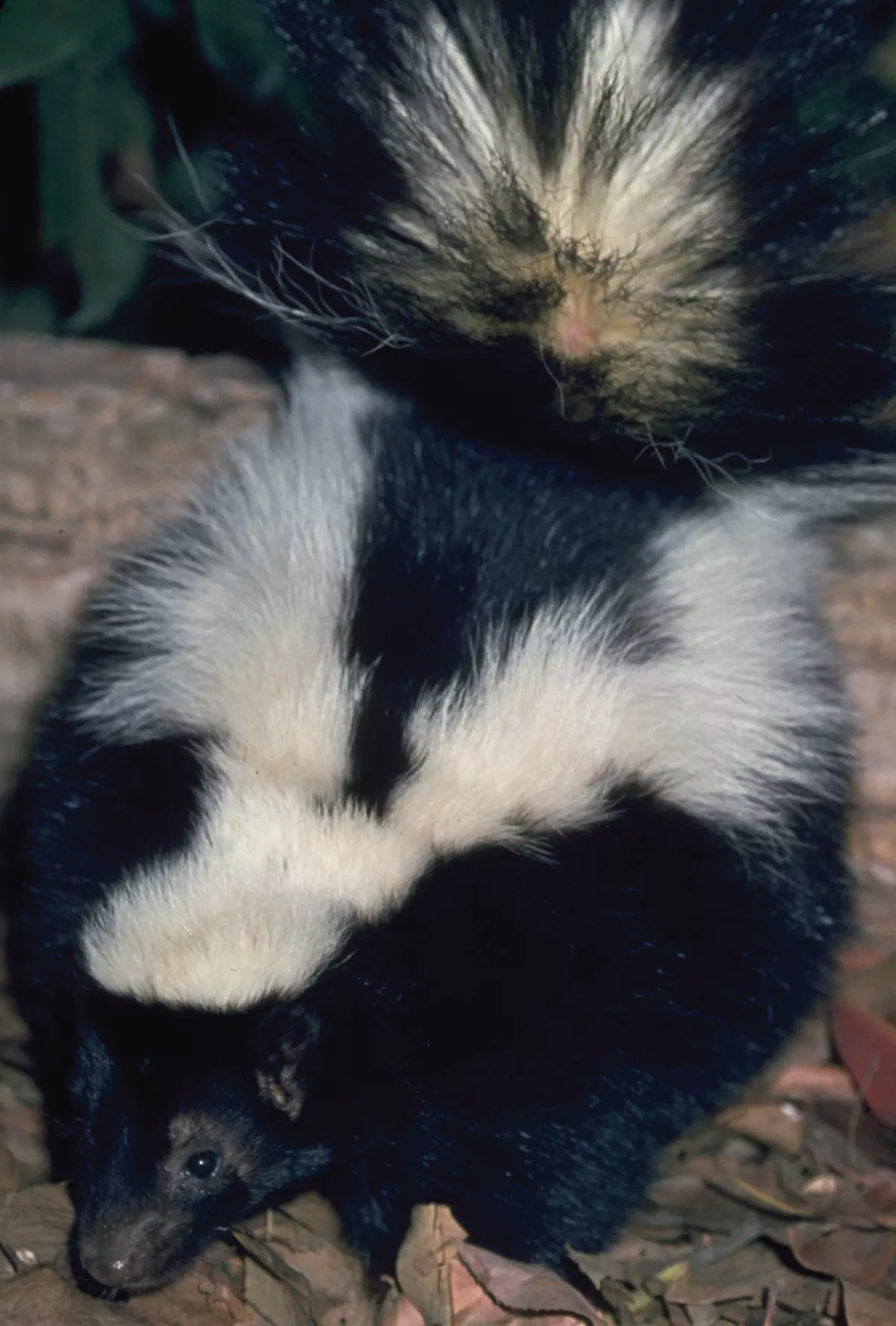Outsmarting skunks, raccoons and opossums — meddlesome critters of the night

With their nimble hands, raccoons can break into many garden enclosures. (Rachel Cobb)
These tips can help make your garden and landscape less hospitable
By Michael Harrelson
(This article first appeared in the June 8, 2024 edition of the San Diego Union-Tribune)
Pepé Le Pew, Rascal and Pogo maybe cute characters on the screen, but skunks, raccoons and opossums are a nuisance in the backyard. They can even be dangerous.
Classified as vertebrate pests by the UC Agriculture and Natural Resources Department, these nocturnal feeders can significantly damage San Diego gardens, fruit trees and lawns. Homeowners are often dismayed in the morning to witness the results of overnight destruction such as stripped fruit trees, dug-up sod, emptied decorative fish and turtle ponds, and dined-upon ready-to-harvest vegetables.
Each of these nocturnal dwellers is distinctly different in appearance and readily identifiable:
- In San Diego County, skunks (Mephitis mephitis) come in two varieties, striped and spotted. The white markings on their black shaggy fur, nose to tail, makes distinguishing one from the other easy.
- Opossums (Didilphis virginiana) have the appearance of a large grayish-white rat with a long, hairless tail. Opossums are marsupials and their tail is prehensile, allowing them to hang upside down from tree branches.
- Raccoons (Procyon lotor) are the largest of these critters of the night, with adults weighing up to 50 pounds. Their brownish fur is highlighted by light and dark rings around their tails and the classic black mask across their eyes.

An opossum forages for food. It is a marsupial that carries its young with it until they can fend for themselves. (Jack Bulmer via unsplash.com)
Although not related biologically, skunks, raccoons and opossums have strongly similar diets, foraging behavior and family structures. They are all active dusk-to-dawn omnivores, eating fruits and vegetables, garbage, pet food, snails, small lizards and snakes, eggs, baby birds, berries, nuts, fish, turtles and bird seed. Each has adapted to urban/suburban environments incredibly well.
None of them hibernate, but all are less active in colder months. Spring litters are typical, with a second litter in summer/fall fairly common. They are all crafty and regularly circumvent efforts to keep them out of the garden. It is challenging when a property owner realizes that one of these night-dwelling vertebrate pests has made the backyard its new playground.
Habitat modification is the key to managing these unwanted visitors. Making a property less hospitable as a source of feeding and nesting is essential.
First, never leave pet food out overnight. Pick up dropped fruits and nuts as a daily routine. Place all food waste in sturdy bins with tight-fitting lids and secure those bins to a post or rack to keep raccoons from tipping them over. Raise the skirts of landscape shrubbery to reduce cover, as the animals seek well-protected spaces when they skitter around in the dark, looking for food.

A striped skunk, common in San Diego, will forage for food from many sources. (Dr. Lloyd Glenn Ingles / California Academy of Sciences)
Skunks, raccoons and opossums will always be alert for a place to set up house. In the wild, they nest in hollow logs, culverts and brush piles. In urban and suburban areas, they will make themselves at home in almost any accessible space, including under decks and patios, in attics and chimneys, and under loosely constructed wood piles.
Preventive measures must be taken. Use 10 gauge ¼-inch wire mesh to seal off any open space around the house. Bury the wire mesh at least 6 inches deep and fan it out to the front another 12 inches, then cover it with dirt. Trim tree branches away from overhanging rooftops a minimum of 5 feet. Remove trellises from outside walls. Organize all wood and lumber piles into tight-fitting stacks away from the house.
Vegetable gardens are more difficult to harden. Building a wire mesh enclosure, buried as previously described, will help. Keep in mind that raccoons, with flexible, handlike paws, can open simple latches. Ordinary fences will not keep out these night creatures, but a single strand of electrified wire strung 8 inches above the ground will exploit their natural sensitivity to mild electric shock and enhance the critter-proofing of your garden. Electrified perimeters are not appropriate for all situations and they must be properly installed.
Learn more about skunks, raccoons and opossums by using the links to the University of California Integrated Pest Management Pest Notes.
For skunks: bit.ly/SkunksPests
For raccoons: bit.ly/RaccoonsPests
For opossums: bit.ly/OpossumsPests
There are a variety of materials and devices advertised as repellants, among them motion-activated flashing lights, screeching devices, and water sprays. Skunks, raccoons and opossums quickly adapt to these mechanical measures and will eventually return. Chemical repellants have been found to be similarly ineffective.
While habitat modification techniques are effective, they are rarely a total solution. In cases where the homeowner’s efforts have proved unsuccessful, wildlife control operators are available in San Diego County. These professionals are equipped to handle problem wildlife in a legal and humane manner.
Never confront one of these animals. When threatened, they can be vicious and a danger to people and pets. In addition, they are common vectors for diseases, including rabies (skunks and raccoons), as well as having tail-borne delivery systems for noxious odors (skunks and opossums).
The rule of thumb is to watch the cute ones on TV and use recommended measures to keep the real critters of the night away from home and garden. They are not pets. Do not feed them. They are experts at surviving in the wild and keeping them there is in everyone’s best interest.
Harrelson has been a San Diego Master Gardener since 2012. He practices low-water landscaping at his home in Jamul.

